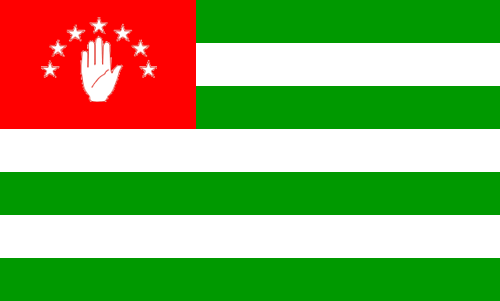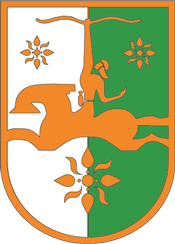On the Historical Symbolism of the State Flag of the Republic of Abkhazia

The open white palm on the red background is a symbol of Abkhazian statehood, which was formed at the time of the Abkhazian Kingdom (VIII-X centuries) and encompasses twelve centuries. Such a representation is attested on the coloured Genoese “portalans” (sea-charts) of the XIII-XIV centuries. A dark-red flag with white palm flew in the Middle Ages above the town of Sebastopolis (otherwise San-Sebastian and the classical Dioskuria, which was founded by the ancient Greeks in the VI-V centuries BC), on which site stands today’s capital of Abkhazia, the city of Sukhum.
The seven 5-pointed stars above the palm are the seven main regions of historical Abkhazia: Sadzen (Dzhigetia), Bzyp, Gwmaa, Abzhwa, Samurzaq’an, Dal-Ts’abal, Pshwy-Aybga. These incorporated the ethnic territory of the Abkhazians from the River Xosta (frontier with the Ubykhs) down to the River Ingur (frontier with Mingrelia) and from the Black Sea to the Caucasus Mountains. Apart from this, the number ‘7’ for Abkhazians (as for many other peoples) is viewed as sacred and is widely attested in their religion, mythology and traditional culture. Also endowed with esteem is the constellation known commonly by the title “The Seven Brothers”.
The 5-pointed star is widespread among the Abkhazians as an ancient astrological symbol. It is found, moreover, on the antique amphors of the Apsilians, the ancestors of the Abkhazians, mentioned by Graeco-Roman authors in the I-II centuries AD.
At the same time the proportions of the flag, the number of stars and the sequence of green-white stripes reflect the fundamental look of the historical flag of the independent North Caucasus Republic (known in the literature as the Mountain Republic), which was proclaimed on 11 May 1918 and which existed for one year. At that period seven states were included in the composition of the Mountain Republic: Daghestan, Chechen-Ingushia, Ossetia, Abkhazia, Kabarda, Adygheia, Karachay-Balkaria. However, already in the second half of June l918 Abkhazia, though part of the Mountain Republic, was occupied (and remained occupied until February l921) by the military forces of the Georgian Democratic Republic; in February l931, with the active participation of Stalin and Beria, Abkhazia was annexed by Soviet Georgia. The green-white sequence of seven stripes (four green, three white) is an indication of the religious tolerance of the Caucasian peoples in the minds of whom Islam (the green) peacefully coexists with Christianity (the white). Abkhazia, as an ancient Christian land from the IV century, together with two others (Ossetia and Kabarda), was represented on the flag of the Mountain Republic by a white stripe.
The modern flag of the Republic of Abkhazia, approved by its Parliament in Sukhum on 23 July l992, symbolises the fundamental stages in the development of the statehood of the Abkhazian nation, one of the oldest autochthonous ethnic groups of the Caucasus, whose language, culture and traditions are especially close to and cognate with those of the North Caucasian peoples, in particular the Abazinians, the Adyghes and the Ubykhs.

Description of the National Coat-of-arms of the Republic of Abkhazia
The coat-of-arms takes the form of a shield, divided vertically into equal sectors of white and green. The outline and central design of the composition are golden.
At the base of the arms is set an 8-pointed star.
In the upper portion of both the white and green sectors are set symmetrically two 8-pointed golden stars.
At the centre of the arms is the figure of a horseman, flying on the fabulous steed, Arash, and shooting an arrow towards the stars. This subject of the arms is linked to an episode in the heroic epic of the Abkhazians, the Narts.
The green symbolises youth and life, the white -- spirituality.
The large golden 8-pointed star is a sign of the sun. The small 8-pointed stars symbolise the union of the two cultural worlds of East and West.